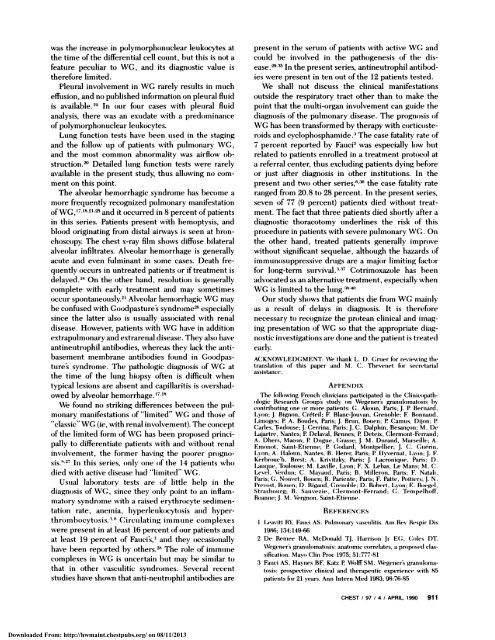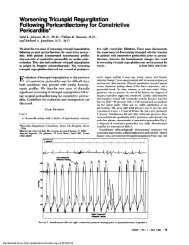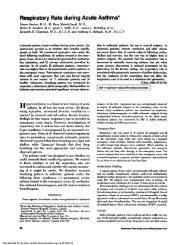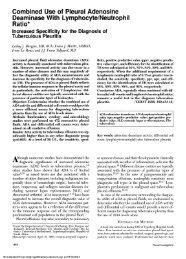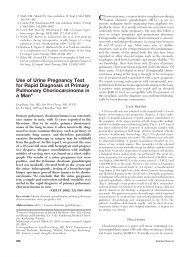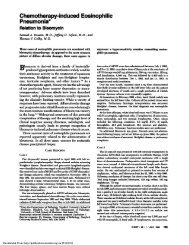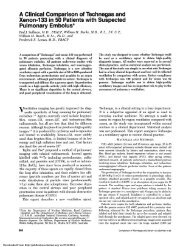Pulmonary Wegener's Granulomatosis*
Pulmonary Wegener's Granulomatosis*
Pulmonary Wegener's Granulomatosis*
Create successful ePaper yourself
Turn your PDF publications into a flip-book with our unique Google optimized e-Paper software.
was the increase in polymorphonuclear leukocytes at<br />
the time of the differential cell count, but this is not a<br />
feature peculiar to WG, and its diagnostic value is<br />
therefore limited.<br />
Pleural involvement in WG rarely results in much<br />
effusion, and no published information on pleural fluid<br />
is available.’ In our four cases with pleural fluid<br />
analysis, there was an exudate with a predominance<br />
(of polymorphonuclear leukocytes.<br />
Lung functioon tests have been used in the staging<br />
and the follow up o)f patients with pulmonary WG,<br />
and the most common abnormality was airflow (ob-<br />
struction.#{176} Detailed lung function tests were rarely<br />
available in the present study, thus allowing rio com-<br />
ment (on this point.<br />
The alveolar hemorrhagic syndrome has become a<br />
more frequently recognized pulmonary manifestation<br />
ofWC,’7”5’21 and it occurred in 8 percent of patients<br />
in this series. Patients present with hemoptysis, and<br />
blood originating from distal airways is seen at bron-<br />
choscopy. The chest x-ray film shows diffuse bilateral<br />
alveolar infiltrates. Alveolar hemorrhage is generally<br />
acute and even fulminant in soome cases. Death fre-<br />
quently occurs in untreated patients or if treatment is<br />
delayed.’8 On the oother hand, resolution is generally<br />
complete with early treatment and may sometimes<br />
occur spontaneously.2#{176} Alveolar hemorrhagic WG may<br />
be confused with Gooodpasture syndrome especially<br />
since the latter also is usually assoociated with renal<br />
disease. However, patients with WG have in addition<br />
extrapulmonary and extrarenal disease. They also have<br />
antineutrophil antibodies, whereas they lack the anti-<br />
basement membrane antibodies found in Gooodpas-<br />
ture’s syndrome. The pathologic diagnosis of WC at<br />
the time of the lung biopsy often is difficult when<br />
typical lesions are absent and capillaritis is overshad-<br />
owed by alveolar 0708<br />
We fcound no striking differences between the pill-<br />
monary manifestations of “limited” WG and those oof<br />
“classic” WC (ie, with renal invoolvement). The cooncept<br />
O)f tile limited form o)f WG has been proposed princi-<br />
pally to differentiate patients with and without renal<br />
invoolvemellt, the former having the poorer proogno-<br />
sis.#{176}27Iii this series, only OOC oof the 14 patients whoo<br />
died with active disease had “limited” WC.<br />
Usual laboratory tests are oof little help in the<br />
diagnosis<br />
matoorytation<br />
of WG,<br />
syndrome<br />
rate , anenlia,<br />
since<br />
witil<br />
they only point<br />
a raised erythroocyte<br />
hyperleukoocytosis<br />
to) an inflamsedimen-<br />
and hyperthroombocytosis.)6<br />
Circulating immune co)mplexes<br />
were Present iii at least 16 percent oofour patients and<br />
at least 19 percent of Fauci’s,#{176} and they (occasionally<br />
have been reported by o)thers. The roole of immune<br />
complexes in WG is uncertain but may he similar to<br />
that in other vasculitic syndromes. Several recent<br />
studies have shown that anti-neutroophil antibodies are<br />
Downloaded From: http://hwmaint.chestpubs.org/ on 08/11/2013<br />
present in the serum oof patients with active WG and<br />
could be invoolved in the pathogenesis of the dis-<br />
ease.’#{176} In the present series, antineutro)phil antihod-<br />
ies were present in ten out ofthe 12 patients tested.<br />
We shall not discuss the clinical manifestations<br />
outside the respiratory tract o)ther than to make the<br />
point that the multi-organ involvement can guide the<br />
diagnosis of the pulmonary disease. The prognoosis of<br />
WG has been transformed by therapy with corticooste-<br />
rooids and cycloophosphamide.3 The case fatality rate of<br />
7 percent reported by Fauci3 was especially low hut<br />
related to) patients enrolled in a treatment protocoi at<br />
a referral center, thus excluding patients dying before<br />
or just after diagnosis in other institutions. In the<br />
present and two other series,6’ the case fatality rate<br />
ranged from 20.8 to) 28 percent. In the present series,<br />
seven of 77 (9 percent) patients died without treat-<br />
ment. The fact that three patients died shortly after a<br />
diagncstic thoracotomy underlines the risk (of this<br />
procedure in patients with severe pulmonary WC. On<br />
the other hand, treated patients generally improve<br />
without significant sequelae, although the hazards of<br />
immunoosuppressive drugs are a major limiting factor<br />
foir long-term survivai.’ Cotrimoxazole has been<br />
advocated as an alternative treatment, especially when<br />
WG is limited to the lung.’#{176}”#{176}’#{176}<br />
Our study shows that patients die from WG mainly<br />
as a result of delays in diagnoosis. It is therefore<br />
necessary to recognize the protean clinical and imag-<br />
ing presentation cof WG so that the approopriate diag-<br />
noostic investigations are done and the patient is treated<br />
earl)<br />
ACKNOWLEDGMENT: Ve thank L. D. Cnoer for reviewing the<br />
translation o)f this paper and NI. C. Thevenet four secretarial<br />
assistamice.<br />
APPENDIX<br />
The foollowing French clinicians participated in the Clinicoopathoulogic<br />
Research<br />
contributing one<br />
Crotop’s<br />
our moore<br />
study<br />
patients:<br />
on Wegener’s<br />
C. Akotmn,<br />
granuloumnatosis<br />
Paris; J. P Bernard,<br />
b)V<br />
Lvun; J. Bignon, Cr#{233}teil; F. Blanc-Jouvan, Grenoble; F. Bo)nns010d,<br />
Limoges;<br />
Caries,<br />
P A. Boudes, Paris;<br />
Tooulouuse; J. Cerrina,<br />
J. Bran,<br />
Paris; J. C.<br />
Rouemm;<br />
Dalphin,<br />
P Camus, Dijon;<br />
Besan#{231}’omi; M .<br />
P<br />
Dc<br />
Lajartre,<br />
A. Dhers,<br />
Nantes;<br />
Macon;<br />
P. Delaval,<br />
P 1)ugioe,<br />
Rennes;<br />
Crasse;<br />
P Deteix, Clermont-Ferramod;<br />
J. NI. Durand, Marseille; A.<br />
Emnoomiot, Saint-Etienne; P Godard, Moontpo’llier; J. C. Cto#{233}rimi,<br />
Lyon; A. llaloumomi,<br />
Kerhrouimc’h, Brest;<br />
Nantes;<br />
A.<br />
B. Ilerer,<br />
Krivitzk;<br />
Paris;<br />
Paris:<br />
P llyvernat,<br />
J. Lacromiiojmme,<br />
Lyon;<br />
Paris:<br />
J. F.<br />
0.<br />
L5UO(110e, TO)(Ol000Se; NI. Laville, Lyon; F. X. Lehas, Le Mans; NI. C.<br />
Level, Verolumi; C. Mayaud, Paris; B. Milleron, Paris; F. Natali,<br />
Paris; C. Nootovet, Rouuemo; R. Panente, Paris; F. Patte, Poitiers; J. N.<br />
Prevost. Rooiocn; 0. Rigatid, Crenooble: D. Roohert, Lyon; E. Rowgel.<br />
Straslouomrg; B. Saoovezie, Clermoont-Ferrand; C . Tenipelhouff,<br />
Rooanmme; J. M. V#{235}rgnoomm, Saint-Etiemone.<br />
REFERENCES<br />
1 Leavitt R1 Fatoci AS. Pimlmummary vasculitis. Am Rev Ito-spir Dis<br />
1986; 134:149-66<br />
2 Dc Remee BA, McDoonakl TJ, liarrisomi Jr EC, Cooles DT<br />
Wegener’s granuhumatosis: anatoomic correlates, a proposed clas-<br />
sificatioun. Mayoo Clin Proc 1975; 51:777-8 1<br />
3 Fauci AS, Haynes BF, Katz P, Wolff SM. Vegener granioloomso-<br />
tosis: prospective clinical and therapeutic experiemice with 85<br />
patients for 21 years. Ann lntern Med 1983; 98:76-85<br />
CHEST I 97 I 4 I APRIL 1 990 911


